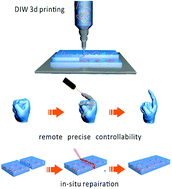3D printing of thermoreversible polyurethanes with targeted shape memory and precise in situ self-healing properties†
Abstract
The formation of durable 3D parts composed of functional polymers for intelligent devices such as robots is highly desirable. Here, we demonstrate the synthesis, 3D printing and applications of thermoreversible shape-memory polyurethanes (PDAPUs), which show good stability, ease of 3D printability, and excellent light control for precise self-healing and targeted shape memory (SM). As a breakthrough in the making of traditional smart devices, the combination of the 3D printing technology with SM characteristics facilitates the manufacturing of smart devices particularly with complex 3D structures, which enables arbitrary transformation between permanent and temporary 3D shapes. The reactive cross-linking of aniline trimer (AT) in PDAPU networks endows the polymers with improved mechanical properties and an efficient photothermal effect. Taking advantage of the spatial characteristics of 3D structures and the ease of control of light, the PDAPUs can achieve targeted shape restoration. Furthermore, the NIR laser can also be used to precisely trigger in situ self-healing of the PDAPUs without damaging their original 3D structures, which is particularly important for extending the lifespan of functional parts with specific structures. Moreover, the PDAPUs are recyclable and can be reprinted. The present research shows the promising potential of PDAPUs for next-generation intelligent devices.



 Please wait while we load your content...
Please wait while we load your content...